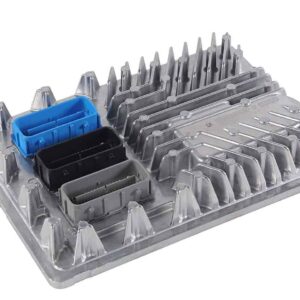Restore Your GM Truck’s Core Performance
Is your 2017 GMC Yukon or other GM vehicle acting erratically? Stalling, poor fuel economy, a persistent check engine light, or even a no-start condition can often be traced back to a single, critical component: the Engine Control Module (ECM). As a technician with over two decades of experience under the hood, I’ve seen firsthand how a failing ECM can cause a cascade of frustrating, hard-to-diagnose issues. It’s the brain of your engine, and when it falters, nothing else works correctly.
This isn’t just a replacement part; it’s a direct solution. We provide a genuine GM Engine Control Module, part number 12674472, that comes professionally programmed to your vehicle’s specific Vehicle Identification Number (VIN). This means it arrives with the latest, most stable software updates from General Motors already installed. You get a component that’s ready for installation, eliminating the need for expensive dealership programming and getting you back on the road faster.
Common Symptoms of a Failing Engine Computer
If you’re experiencing any of the following, a faulty ECM could be the culprit. I’ve diagnosed hundreds of these, and the signs are often consistent:
- ✔ Check Engine Light is on with codes like P0601, P0606, or other internal processor faults.
- ✔ The engine cranks but refuses to start.
- ✔ Unexplained drops in fuel mileage.
- ✔ The vehicle stalls intermittently, either while driving or at idle.
- ✔ Rough running, misfires, or hesitation during acceleration.
- ✔ Communication errors with other modules (e.g., U0100).
- ✔ Transmission shifting problems or erratic behavior.
A Technician’s Notebook
I remember a 2017 Sierra 1500 that came into the bay with a laundry list of issues. The owner had already replaced spark plugs, coils, and even a fuel pump trying to chase down a random misfire and stalling problem. The codes were all over the place. After checking the basics, my gut told me to look at the ECM’s data stream. The sensor readings were jumping erratically, but the sensors themselves tested fine. This pointed to a processing failure inside the ECM. We installed a VIN-programmed module like this one, performed the quick crankshaft variation relearn, and the truck ran like it just left the factory. It saved the customer from throwing more money at parts he didn’t need.
Your Straightforward ECM Installation Guide
Replacing the 2017 Yukon Engine Module is a manageable job for a DIY enthusiast or a quick task for a professional. The key is the post-installation procedure.
- Safety First: Always disconnect the negative terminal from your vehicle’s battery before starting any electrical work.
- Locate the ECM: On most GM trucks and SUVs like the Yukon and Tahoe, the ECM is located in the engine compartment, typically on the driver’s side (LH front).
- Disconnect and Remove: Carefully unplug the electrical connectors. There are usually locking tabs that need to be released. Once disconnected, unbolt the old module from its mounting bracket.
- Install the New Module: Bolt the new, pre-programmed ECM into place and securely reconnect all electrical connectors. Ensure they click into place.
- Reconnect Battery: Reattach the negative battery terminal.
- Perform Relearn Procedures: Attempt to start the vehicle. If it does not start, the GM Vehicle Theft Deterrent (VTD) system needs to be relearned. This requires a tool with GM software access (like TIS2WEB/Techline Connect). This is a standard security step for modern vehicles. Other procedures like a crankshaft position variation relearn may also be required for optimal performance. This is the responsibility of the installer.
Verified Fitment For These GM Vehicles
This module, part number 12674472, is a direct replacement for several other part numbers including 12692068, 12704476, 12686382, 12674052, and 12678815. It is compatible with a wide range of GM models. Please verify your vehicle is on this list:
- Cadillac ATS (2017): 3.6L, VIN Y (LF4)
- Cadillac CTS (2017): 6.2L (Supercharged) or 3.6L, VIN 8 (LF3 Twin Turbo)
- Cadillac Escalade / ESV (2017)
- Cadillac XTS (2017): 3.6L, VIN 8 (LF3)
- Chevrolet Corvette (2017)
- Chevrolet Silverado 1500 (2016-2018)
- Chevrolet Suburban (2017)
- Chevrolet Tahoe (2017)
- GMC Sierra 1500 / Denali 1500 (2016-2018)
- GMC Yukon / Yukon XL (2017)
Do I really need to provide my VIN?
Do I really need to provide my VIN?
Yes, absolutely. Providing your VIN is the most critical step. We use it to load the precise, factory-correct software and calibrations for your specific vehicle’s engine, transmission, and options. This ensures compatibility and proper function right out of the box.
What is a ‘theft relearn’ and can I do it myself?
The Vehicle Theft Deterrent (VTD) relearn is a security procedure that syncs the new ECM to your vehicle’s ignition key and other security modules. If not performed, the system thinks the vehicle is being stolen and will prevent it from starting. While some older GM models had a simple key-cycle procedure, most vehicles on this fitment list require a professional scan tool with access to GM’s TIS2WEB or Techline Connect software. Most independent repair shops can perform this service.
Is this a better option than a part from a salvage yard?
Definitely. A salvage yard ECM will be programmed to the donor vehicle’s VIN and options, not yours. It would still require complete reprogramming by a dealer or specialist, often at a high cost, and you wouldn’t get the latest software updates. Our module comes ready for your vehicle, saving significant time, money, and hassle.
Will this 2017 Yukon Engine Module fix my check engine light?
If the check engine light is caused by an internal failure of the ECM (common codes P0601-P0606) or faulty processing, then yes, this will resolve the issue. However, it’s crucial to ensure the problem isn’t a bad sensor or wiring harness first. A proper diagnosis is always recommended.



